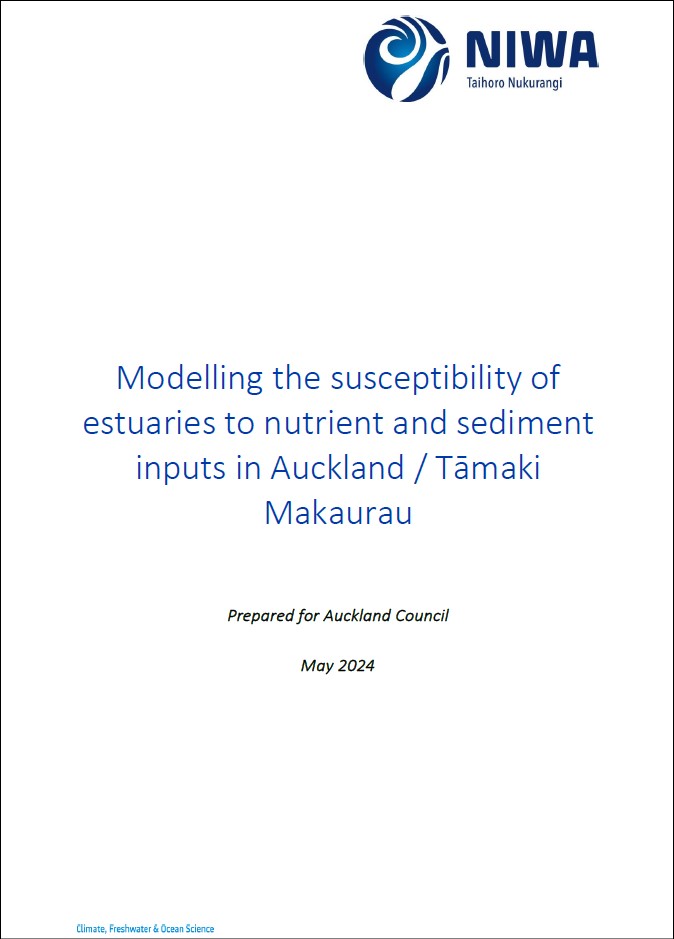Modelling susceptibility of estuaries to nutrient and sediment inputs in Auckland / Tāmaki Makaurau
Author:
National Institute of Water and Atmospheric Research Ltd, NIWA, Bruce Dudley, David Plew, Glen Reeve, Zhonghou Xu, Thanh Dang, Ude Shankar, Steven HolmesSource:
Auckland Council | NIWAPublication date:
2024Topics:
EnvironmentExecutive summary
Auckland Council require an analytical framework to inform the limit setting process with respect to water quality of fresh water flowing to estuaries. To establish relationships between contaminant loads (nutrients and sediments) and impacts to Auckland’s estuaries, Auckland Council require information on current nutrient and sediment loads at both the estuary scale and at scales relevant to freshwater management (i.e., sub-estuaries of the larger Kaipara, Manukau and Waitematā Harbours and Tāmaki Estuary).
Sediment loads were estimated using an existing NIWA sediment loading model to provide areal sediment loads to the estuaries. Mean annual nutrient loads (total nitrogen and total phosphorus were estimated using CLUES (Catchment Land use for Environmental Sustainability model) or statistical models (available via NZRiverMaps). Estuary Trophic Index (ETI) models were then used to predict nutrient concentrations in the estuaries, the susceptibility of estuaries to nutrient loading from land, and their consequent ecological condition. Small estuaries in the region were assessed using a ‘whole of estuary’ approach, as were sub-estuaries within the four major estuaries in the Auckland region (Manukau, Kaipara, Waitematā and Tāmaki). For these larger estuaries, nutrient concentrations were calculated at sub-estuary scales using existing hydrodynamic numerical models available to NIWA with tracer modelling techniques.
With a few exceptions, sediment load results showed that Auckland region estuary loads were often near to or less than the median for sediment load results nationally. The ‘whole of estuary’ methods using the ETI to determine susceptibility to eutrophication and ecological state indicated that most estuaries in the Auckland region are likely to be in good condition. The ETI methods gave imprecise estimates of nutrient conditions in Auckland’s major estuaries, which contain large sub-estuary systems. Hydrodynamic models highlighted the localised impacts of riverine inputs from some catchments on the estuary arms they flow to. The hydrodynamic models now provide an appropriate method to assess the effects of changes in nutrient loads to Auckland’s larger estuaries.
A limitation of the methods of assessing nutrient concentrations and eutrophication risk in this study is that they use ‘steady-state’ nutrient load estimates based on NIWA’s Catchment Land Use for Environmental Sustainability (CLUES) and NZ River Maps models. Auckland Council’s Freshwater Management Tool (FWMT) should provide a suitable tool to depart from this ‘steady state’ assessment and provide a means to incorporate changes in nutrient load through time into the modelling. However, this work noted that modification of the FWMT would be needed for its use to extend to estuary management, particularly to include parts of estuary catchments not currently covered by this model.
To improve the accuracy of the modelling approaches used in this study, we recommend extending Auckland’s water quality monitoring network to monitor contaminant concentrations and flow rates at terminal river reaches flowing to estuaries, along with maintaining a good understanding of nutrient concentrations in coastal oceanic water in the Auckland region.
Gathering more information to better calibrate ETI predictions for northern New Zealand is also recommended. We recommend that our estimates of ecological impact from contaminant loads to Auckland estuaries are used only as guides for regional quantification of relationships between loads and responses of estuary attributes. This regional quantification is vital to assess the ecological consequences to estuaries and sub-estuaries in the Auckland region resulting from changes in nutrient concentration. It is notable that current eutrophication risk for Auckland estuaries is generally low relative to estuaries nationally (including estuaries in Northland). For this reason, we recommend that Auckland Council scientists consider collaboration with other northern councils (where some estuaries have higher eutrophication risk) when developing nutrient targets for estuaries.
NIWA for Auckland Council, May 2024. Project ARC24501
